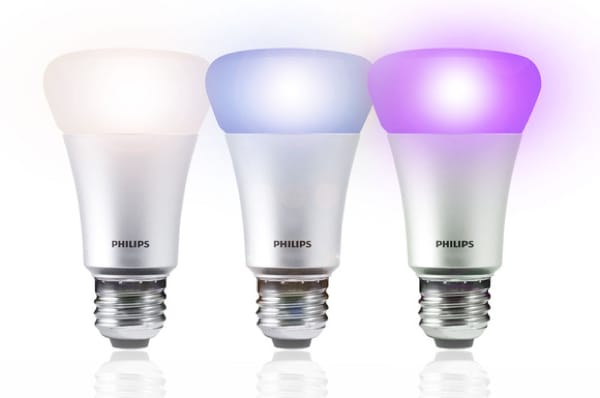Critical Kit: Philips Hue connected lightbulbs

As part of our Critical Kit series, this week we’re taking a short but enlightening look at the Philips Hue connected lightbulbs. While it could argue that they’re not exactly critical, the innovative and popular smart bulbs have certainly struck a chord with consumers.
How does this relate to anything mobile? The Hue range basically comes into its own when controlled by a smartphone – there is an iPhone and Android app available which allows you to control the colours and mood, even when you’re not at home. It’s perhaps the early beginnings of getting our homes connected and integrated with our digital life, our smartphones, and all our other gadgets (smartwatches perhaps in the future), and Philips is currently one of the most well-known companies coming up with great smart home products.
Philips Hue “Personal Wireless Lighting” – a bright idea?
Any time I walk into an Apple store and manage to tear myself away from the rows of tempting aluminium MacBooks and the stunning screen on the new 5K iMac, I’m always drawn to the accessories section where one particular item always stands out – the Philips Hue LED bulbs.
Pitched as a connected bulb that can be programmed to glow in any of millions of colours and controlled by an iPhone (or an iPad), the Hue range seems like a fun idea and one that could brighten up my humble office, which is currently like the black hole of Calcutta (the sun is so bright during the day that I am forced to shutter the windows and draw the curtains early afternoon onwards).
When Hue was first announced a couple of years ago, there was basically one type of bulb that you could buy, connected to a smart bridge that plugged into your router. Today however, Philips has expanded the range to standalone 3D-printed lamps, strip lighting, and a portable model called the Hue Go.
How does Hue work?
Hua is a hybrid system that uses a wireless standard called ZigBee, and it comes with a hub that connected to your Wi-Fi router via a hardwired Ethernet cable. This device then communicates wireless with all your Hua bulbs, and an app on your smartphone then talks with the bridge via your local Wi-Fi network.
Even though there is some additional equipment required (much like the Sonos audio system that we covered a few weeks back), it’s a doddle to set Hue up and start using it. With the app installed on your phone and everything plugged in, that’s where the fun of Hue begins.
Hue lets you choose any of millions of colours using the “Scenes” feature – either take a photo (or choose from any of the pre-supplied ones) and set the colour of each bulb to any point on the picture. Every bulb can be set independently, as long as the colour is used in the picture, although there is also a rainbow to select a colour from.
Once the bulbs have been set to specific colours, you can then adjust the brightness of every bulb, using the dimmer that covers everything from fairly bright (around 600 lumens) to a very low level. However if you do need an extremely bright bulb to light a large room, the Hua falls somewhat short.
Hua also provides an alarm and timer, as well as a location-based geofencing feature so that the lights turn off automatically when you leave home and switch back on when you return home. It all works quite smoothly, but users of the app say there is still some room for improvement in terms of usability.
Various Hue products can be found on Amazon, such as the Hue Personal Wireless Lighting Starter Kit, which sells for around £150.
The rise of the connected home
In the next few months, Apple is supposedly rolling out its HomeKit framework, which will make it even easier to control all aspects of an automated home from the comfort of your sofa, using an iPhone, iPad or perhaps an Apple Watch.
When iOS 8 was introduced last year, Apple announced that developers would soon be able to build gadget that can connect to an iPhone so you can control them, from heating to lighting, smart locks, security and other home appliances.
Besides direct control of various systems, it will also allow you to group products into different rooms, scenes and zones, so that every HomeKit product in a particular room (e.g. the television and lights) could all be turned off with one tap.
HomeKit is similar in concept to the Internet of Things (IoT), the latest buzzword that’s making a splash in the tech industry at the moment. As devices become smaller and cheaper to make, they are increasingly coming with networking capabilities so they can be hooked up to the Internet or a home network.
But HomeKit aims to unify all the various IoT devices into a more complete system, ready to go and controllable by an iOS device. When it’s finally available, various reports say that you’ll be able to control the whole lot via Siri, and that the soon-t0-be-updated Apple TV (expected at WWDC next month) will act as a central hub that makes the whole thing possible and more seamless.
Philips already has an early lead in terms of lighting, and we’re certainly going to see a plethora of new and interesting connected home devices from the company, and others, over the coming few months…









